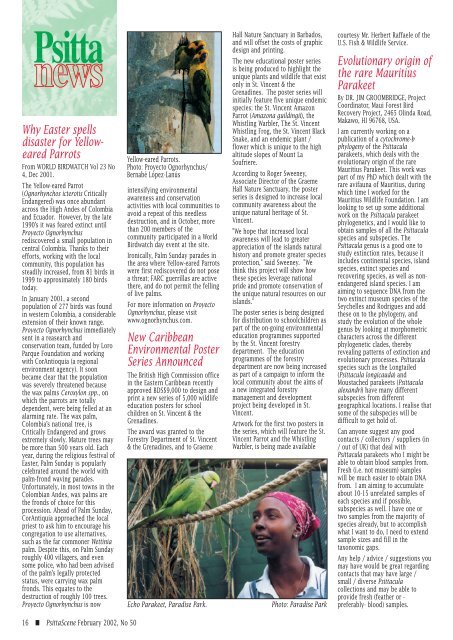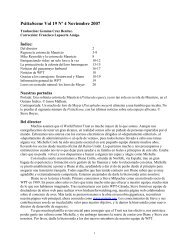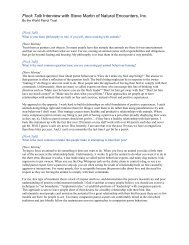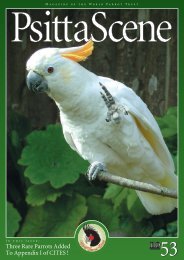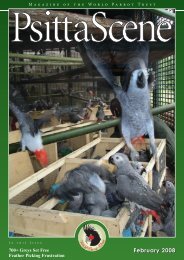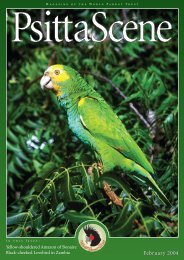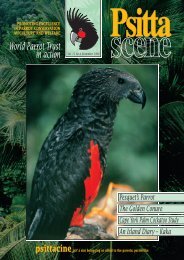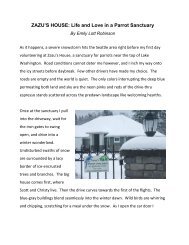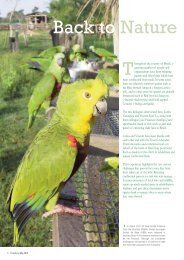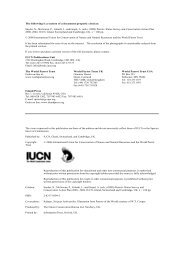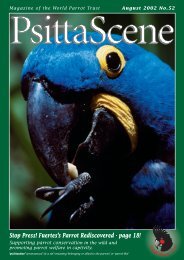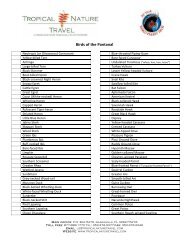Celebrating our 50th Issue! - World Parrot Trust
Celebrating our 50th Issue! - World Parrot Trust
Celebrating our 50th Issue! - World Parrot Trust
Create successful ePaper yourself
Turn your PDF publications into a flip-book with our unique Google optimized e-Paper software.
Why Easter spells<br />
disaster for Yelloweared<br />
<strong>Parrot</strong>s<br />
From WORLD BIRDWATCH Vol 23 No<br />
4, Dec 2001.<br />
The Yellow-eared <strong>Parrot</strong><br />
(Ognorhynchos icterotis Critically<br />
Endangered) was once abundant<br />
across the High Andes of Colombia<br />
and Ecuador. However, by the late<br />
1990’s it was feared extinct until<br />
Proyecto Ognorhynchus<br />
rediscovered a small population in<br />
central Colombia. Thanks to their<br />
efforts, working with the local<br />
community, this population has<br />
steadily increased, from 81 birds in<br />
1999 to approximately 180 birds<br />
today.<br />
In January 2001, a second<br />
population of 277 birds was found<br />
in western Colombia, a considerable<br />
extension of their known range.<br />
Proyecto Ognorhynchus immediately<br />
sent in a reasearch and<br />
conservation team, funded by Loro<br />
Parque Foundation and working<br />
with CorAntioquia (a regional<br />
environment agency). It soon<br />
became clear that the population<br />
was severely threatened because<br />
the wax palms Ceroxylon spp., on<br />
which the parrots are totally<br />
dependent, were being felled at an<br />
alarming rate. The wax palm,<br />
Colombia’s national tree, is<br />
Critically Endangered and grows<br />
extremely slowly. Mature trees may<br />
be more than 500 years old. Each<br />
year, during the religious festival of<br />
Easter, Palm Sunday is popularly<br />
celebrated around the world with<br />
palm-frond waving parades.<br />
Unfortunately, in most towns in the<br />
Colombian Andes, wax palms are<br />
the fronds of choice for this<br />
procession. Ahead of Palm Sunday,<br />
CorAntiquia approached the local<br />
priest to ask him to enc<strong>our</strong>age his<br />
congregation to use alternatives,<br />
such as the far commoner Wettinia<br />
palm. Despite this, on Palm Sunday<br />
roughly 400 villagers, and even<br />
some police, who had been advised<br />
of the palm’s legally protected<br />
status, were carrying wax palm<br />
fronds. This equates to the<br />
destruction of roughly 100 trees.<br />
Proyecto Ognorhynchus is now<br />
Yellow-eared <strong>Parrot</strong>s.<br />
Photo: Proyecto Ognorhynchus/<br />
Bernabé López-Lanús<br />
intensifying environmental<br />
awareness and conservation<br />
activities with local communities to<br />
avoid a repeat of this needless<br />
destruction, and in October, more<br />
than 200 members of the<br />
community participated in a <strong>World</strong><br />
Birdwatch day event at the site.<br />
Ironically, Palm Sunday parades in<br />
the area where Yellow-eared <strong>Parrot</strong>s<br />
were first rediscovered do not pose<br />
a threat; FARC guerrillas are active<br />
there, and do not permit the felling<br />
of live palms.<br />
For more information on Proyecto<br />
Ognorhynchus, please visit<br />
www.ognorhynchus.com.<br />
New Caribbean<br />
Environmental Poster<br />
Series Announced<br />
The British High Commission office<br />
in the Eastern Caribbean recently<br />
approved BDS$9,000 to design and<br />
print a new series of 5,000 wildlife<br />
education posters for school<br />
children on St. Vincent & the<br />
Grenadines.<br />
The award was granted to the<br />
Forestry Department of St. Vincent<br />
& the Grenadines, and to Graeme<br />
Echo Parakeet, Paradise Park.<br />
Hall Nature Sanctuary in Barbados,<br />
and will offset the costs of graphic<br />
design and printing.<br />
The new educational poster series<br />
is being produced to highlight the<br />
unique plants and wildlife that exist<br />
only in St. Vincent & the<br />
Grenadines. The poster series will<br />
initially feature five unique endemic<br />
species; the St. Vincent Amazon<br />
<strong>Parrot</strong> (Amazona guildingii), the<br />
Whistling Warbler, The St. Vincent<br />
Whistling Frog, the St. Vincent Black<br />
Snake, and an endemic plant /<br />
flower which is unique to the high<br />
altitude slopes of Mount La<br />
Soufriere.<br />
According to Roger Sweeney,<br />
Associate Director of the Graeme<br />
Hall Nature Sanctuary, the poster<br />
series is designed to increase local<br />
community awareness about the<br />
unique natural heritage of St.<br />
Vincent.<br />
"We hope that increased local<br />
awareness will lead to greater<br />
appreciation of the islands natural<br />
history and promote greater species<br />
protection," said Sweeney. "We<br />
think this project will show how<br />
these species leverage national<br />
pride and promote conservation of<br />
the unique natural res<strong>our</strong>ces on <strong>our</strong><br />
islands."<br />
The poster series is being designed<br />
for distribution to schoolchildren as<br />
part of the on-going environmental<br />
education programmes supported<br />
by the St. Vincent forestry<br />
department. The education<br />
programmes of the forestry<br />
department are now being increased<br />
as part of a campaign to inform the<br />
local community about the aims of<br />
a new integrated forestry<br />
management and development<br />
project being developed in St.<br />
Vincent.<br />
Artwork for the first two posters in<br />
the series, which will feature the St.<br />
Vincent <strong>Parrot</strong> and the Whistling<br />
Warbler, is being made available<br />
Photo: Paradise Park<br />
c<strong>our</strong>tesy Mr. Herbert Raffaele of the<br />
U.S. Fish & Wildlife Service.<br />
Evolutionary origin of<br />
the rare Mauritius<br />
Parakeet<br />
By DR. JIM GROOMBRIDGE, Project<br />
Coordinator, Maui Forest Bird<br />
Recovery Project, 2465 Olinda Road,<br />
Makawo, HI 96768, USA.<br />
I am currently working on a<br />
publication of a cytochrome-b<br />
phylogeny of the Psittacula<br />
parakeets, which deals with the<br />
evolutionary origin of the rare<br />
Mauritius Parakeet. This work was<br />
part of my PhD which dealt with the<br />
rare avifauna of Mauritius, during<br />
which time I worked for the<br />
Mauritius Wildlife Foundation. I am<br />
looking to set up some additional<br />
work on the Psittacula parakeet<br />
phylogenetics, and I would like to<br />
obtain samples of all the Psittacula<br />
species and subspecies. The<br />
Psittacula genus is a good one to<br />
study extinction rates, because it<br />
includes continental species, island<br />
species, extinct species and<br />
recovering species, as well as nonendangered<br />
island species. I am<br />
aiming to sequence DNA from the<br />
two extinct museum species of the<br />
Seychelles and Rodrigues and add<br />
these on to the phylogeny, and<br />
study the evolution of the whole<br />
genus by looking at morphometric<br />
characters across the different<br />
phylogenetic clades, thereby<br />
revealing patterns of extinction and<br />
evolutionary processes. Psittacula<br />
species such as the Longtailed<br />
(Psittacula longicauda) and<br />
Moustached parakeets (Psittacula<br />
alexandri) have many different<br />
subspecies from different<br />
geographical locations. I realise that<br />
some of the subspecies will be<br />
difficult to get hold of.<br />
Can anyone suggest any good<br />
contacts / collectors / suppliers (in<br />
/ out of UK) that deal with<br />
Psittacula parakeets who I might be<br />
able to obtain blood samples from.<br />
Fresh (i.e. not museum) samples<br />
will be much easier to obtain DNA<br />
from. I am aiming to accumulate<br />
about 10-15 unrelated samples of<br />
each species and if possible,<br />
subspecies as well. I have one or<br />
two samples from the majority of<br />
species already, but to accomplish<br />
what I want to do, I need to extend<br />
sample sizes and fill in the<br />
taxonomic gaps.<br />
Any help / advice / suggestions you<br />
may have would be great regarding<br />
contacts that may have large /<br />
small / diverse Psittacula<br />
collections and may be able to<br />
provide fresh (feather or -<br />
preferably- blood) samples.<br />
16 ■ PsittaScene February 2002, No 50


